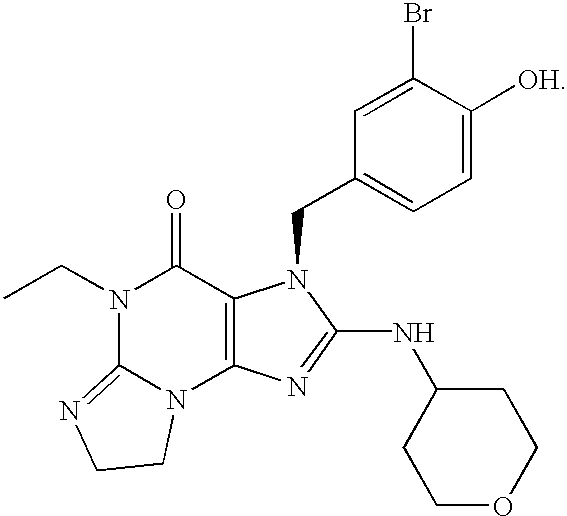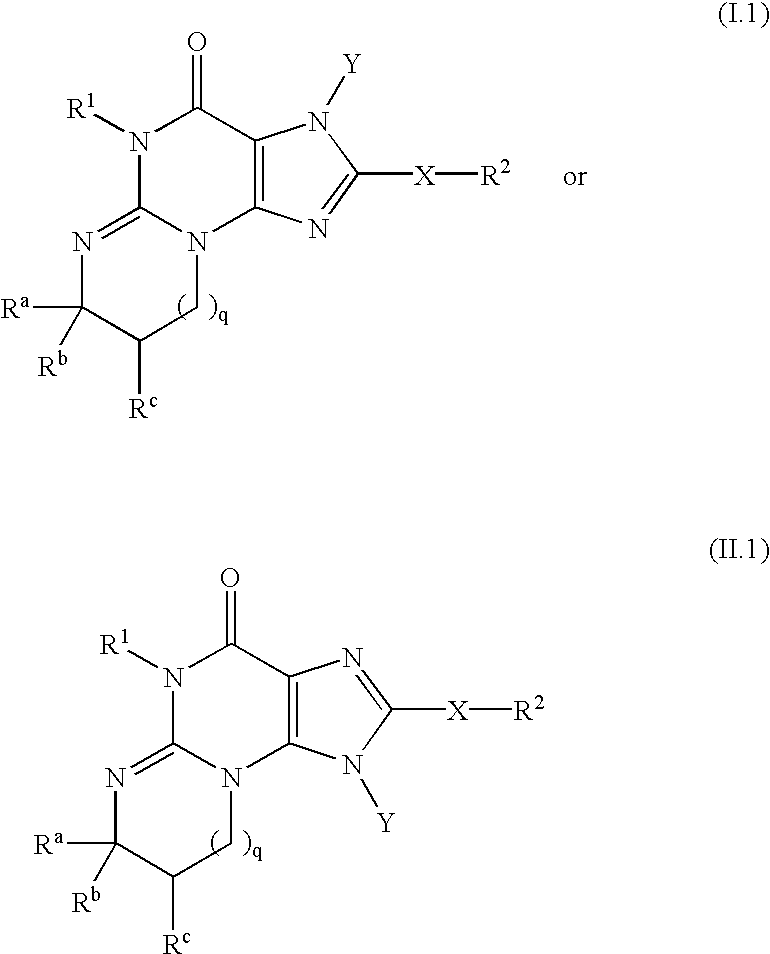Polycyclic guanine phosphodiesterase V inhibitors
a phosphodiesterase and polycyclic nucleotide technology, applied in the field of polycyclic nucleotide guanine phosphodiesterase v inhibitors, can solve the problems of erectile dysfunction
- Summary
- Abstract
- Description
- Claims
- Application Information
AI Technical Summary
Benefits of technology
Problems solved by technology
Method used
Image
Examples
example 1
[0248]
A mixture of Preparation 1 (58 g, 0.15 mol), ammonium formate (350 g, 5.5 mol) and 20% Pd(OH)2 / C (25 g) in MeOH (1.3 L) was refluxed for 3 h. The reaction mixture was allowed to cool, additional ammonium formate (100 g, 1.6 mol) and 20% Pd(OH)2 / C (25 g) was added, and the mixture was refluxed for 2 h. The reaction mixture was filtered and the filtrate was concentrated. The residue was dissolved in CH2Cl2 (3 L), washed with sat'd NaHCO3, dried (MgSO4), filtered and evaporated to give the product (37 g, 84%). 1H NMR (300 MHz, CDCl3) δ 7.62 (1H, s), 7.35-7.18 (5H, m), 4.55 (1H, m), 4.19-3.95 (3H, m), 3.90 (1H, m), 3.21 (1H, m), 2.78 (1H, m), 1.35 (3H, t, J=7 Hz).
To a solution of the product of Step 1 (17 g, 58 mmol) in AcOH (700 ml) was added sodium acetate (10 g, 0.12 mol) and Br2 (12.5 g, 78 mmol), and the reaction mixture was stirred at 50° C. for 12 h. After the reaction mixture had cooled to RT, sodium bisulfite (40 g) was added and the whole was concentrated. The residue w...
example 2
[0249]
Reaction of Preparation 2 with Pd(OH)2 / C and ammonium formate in MeOH by essentially the procedure described in Example 1, Step 1 gave the product. 1H NMR (300 MHz, CDCl3) δ 7.81 (s, 1H), 6.1 (br, 1H), 5.03 (1H, t, J=7.2 Hz), 4.86 (1H, t, J=7.2 Hz), 4.05 (2H, m), 2.35 (1H, m), 2.15 (1H, m), 2.00-1.80 (3H, m), 1.62 (1H, m), 1.24 (3H, t, J=7.2 Hz). MS (ES) m / e 246 (M+H)+.
A mixture of the product of Step 1 (2.1.1) (2.10 g, 8.5 mmol), 3-bromo-4-methoxybenzylbromide (Preparation 8; 3.60 g, 12.9 mmol), and K2CO3 (3.55 g, 25.7 mmol) was stirred overnight, diluted with dichloromethane, washed with water, dried (Na2SO4), filtered, and concentrated. The residue was purified by flash chromatography (gradient 99:1-97:3 CH2Cl2 / MeOH) to give the product (3.02 g, 79%). MS (ES) m / e 444 (M+H)+.
Reaction of the product of Step 1 (2.1.1) with 3-chloro-4-methoxybenzylbromide (Preparation 9) by essentially the same procedure afforded the following product.
To a solution of the product of Step 2 (2...
example 3
[0250]
To a mixture of the product of Example 2, Step 3 (2.3.1) (20 mg, 0.038 mmol) and CH2Cl2 (1 ml) was added 1M solution of BBr3 in CH2Cl2 (0.2 ml, 0.19 mmol). The mixture was stirred for 30 min, quenched with aq. NH3, extracted with CH2Cl2, dried (Na2SO4), filtered and evaporated to afford the product (15 mg, 76%). 1H NMR (300 MHz, CDCl3) δ 7.58 (1H, d, J=1.7 Hz), 7.31 (1H, dd, J=1.7, 8.2 Hz), 6.97 (1H, d, J=8.2 Hz), 5.34 (2H, s), 4.79 (1H, t, J=7.0 Hz), 4.71 (1H, t, J=7.0 Hz), 4.0 (2H, q, J=7.0 Hz), 2.21 (1H, dd, J=6.0, 13 Hz), 1.95 (1H, m), 1.78 (3H, m), 1.54 (1H, m), 1.25, (3H, t, J=7.0 Hz). MS (ES) m / e 508 (M+H)+.
PUM
| Property | Measurement | Unit |
|---|---|---|
| temperature | aaaaa | aaaaa |
| temperature | aaaaa | aaaaa |
| pH | aaaaa | aaaaa |
Abstract
Description
Claims
Application Information
 Login to View More
Login to View More - R&D
- Intellectual Property
- Life Sciences
- Materials
- Tech Scout
- Unparalleled Data Quality
- Higher Quality Content
- 60% Fewer Hallucinations
Browse by: Latest US Patents, China's latest patents, Technical Efficacy Thesaurus, Application Domain, Technology Topic, Popular Technical Reports.
© 2025 PatSnap. All rights reserved.Legal|Privacy policy|Modern Slavery Act Transparency Statement|Sitemap|About US| Contact US: help@patsnap.com



